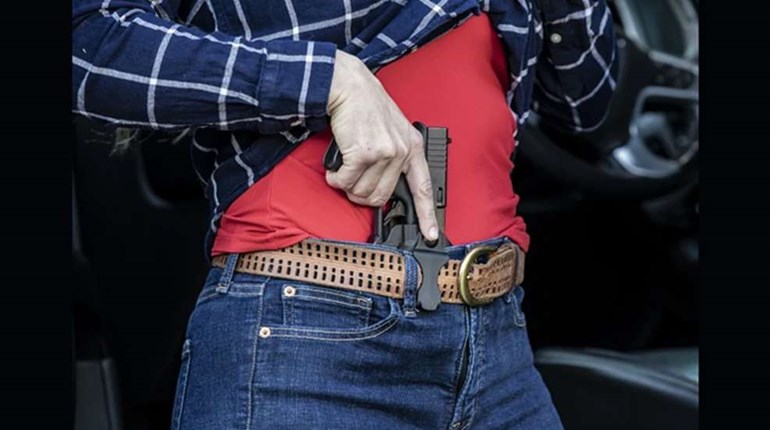
Ruger rose to prominence on a series of rugged, reliable firearms with price tags that weren't out of reach of people with house payments and kids in braces. In the 1980s, the company entered the "WonderNine" market with its P85, which eventually spawned a whole swarm of successors in various calibers. These guns were popular in the civilian market because they carried on the Ruger tradition of ruggedness, reliability and a reasonable sticker price.
Unfortunately, as the '80s gave way to the '90s, fashions changed in the handgun market. Hair metal gave way to the grunge sound, and large, all-metal, double-action semi-automatics were swamped in the market by slimmer, polymer-frame handguns. Further, the conventional wisdom swung to embrace the double-action-only pull of the striker-fired mechanism.
Ruger responded to the market swing with its SR9, a thoroughly modern, polymer-frame, striker-fired pistol. It was slim in the hand, featured a backstrap that could be flipped to change it from arched to flat, had an ambidextrous magazine release and thumb safety—and in the process closed a lot of the price gap between Ruger's semi-auto line and its rivals from makers like Glock and Smith & Wesson. Something had to be done if Ruger was to maintain its role as purveyor of quality guns to shooters on a budget.
Enter the new Ruger 9E. Essentially, the company took its SR9 and looked at the design to see where it could shave cost without affecting ruggedness and reliability.
The most obvious difference is the pistol arrives in a white cardboard box rather than the plastic clamshell case of more expensive models. The next is apparent when one opens the cardboard box and immediately sees the sticker on the underside of the lid informing the purchaser that the pistol had been shipped with only one magazine.
Pulling the pistol out of the box, one could be forgiven for not immediately noticing any difference between it and the SR9, which sports an MSRP about $100 more than the 9E. I had to ask the guy at the shop to get an SR9 out of the case to compare them side-by-side.

Basically, Ruger eliminated a lot of largely cosmetic machining on the slide. A couple of ball end mill beauty cuts up on the nose went away, three flat bevels along the top of the slide are used rather than the compound curves of the more expensive gun, and it has half as many slide serrations. Further, the slide is plain, matte-blue carbon steel, rather than stainless or the nitride finish found on the SR9.
Most noticeably, the predecessor's pop-up-style loaded-chamber indicator is replaced in the 9E with a simple witness hole in the top rear edge of the chamber hood, eliminating further machining steps as well as the moving parts of the indicator. From the slide rails down, the rest of the gun is a straight-up SR9, complete with reversible backstrap, ambidextrous safety and magazine release. There's also an accessory rail on the dust cover.
Performance-wise, the pistol runs like you'd expect, given its parentage. Other than a seriously out-of-spec batch of budget FMJ (115-grain bullets at slower than 1,000 fps won't run most guns reliably), the pistol didn't experience a single malfunction with a variety of ammo from Winchester, Federal, Black Hills and Sellier & Bellot. Recoil control is aided by the very slim grip—measuring the grip circumference around the trigger and backstrap yielded 6.88 inches, the same circumference as a Smith & Wesson M&P wearing its small backstrap. The trigger was a little crunchy out of the box, which is hardly unusual for a new striker-fired gun, and measured about 7 pounds on my RCBS scale.

The thumb safety feels like something of an afterthought, but the 800-pound gorilla of this particular market segment doesn't even have one, so there's that. My only real ergonomic gripe was with the magazine release which, like the original one on a 1911, took a little shifting of the gun in my hand to actuate with my strong-side thumb. Being an ambidextrous button, however, it was plenty easy to actuate from the other side with my trigger finger.
Accuracy was measured off a rest at 25 yards on a teeth-chattering cold day, so take that into account. I'd say that the one sub-3-inch group turned in by the Black Hills 115-grain JHP early in the range session is a lot closer to representing the pistol's potential than the 7-inch-plus group shot with the 124-grain Winchester NATO ammo at "I-can't-feel-my-fingers-anymore-can-I-go-home-now?" o'clock.
I was impressed with the 9E. Ruger's reputation for rugged reliability at reasonable rates is safe with this pistol. It carries the torch as a great value for the money, even allowing for having to purchase a second magazine separately. Based on my experience with the 9E, I wouldn't hesitate to carry it.
Specifications
Manufacturer: Ruger; (928) 541-8892
Action Type: Recoil-operated, striker-fired, semi-automatic
Caliber: 9 mm
Capacity: 17 rounds
Frame: Glass-filled nylon
Slide Length: 7.5 inches
Barrel Length: 4.14 inches
Rifling: 6 grooves; 1:10-inch RH twist
Sights: White dot front, two white dot rear
Trigger Pull Weight: 7 pounds
Length: 7.5 inches
Width: 1.27 inches
Height: 5.53 inches
Weight: 27.2 ounces
Accessories: One magazine, lock, manual
MSRP: $429
Shooting Results
| Load | Velocity | Group size | ||
| Smallest | Largest | Average | ||
| Black Hills 115-grain JHP EXP | 1,214 | 2.00 | 5.55 | 3.99 |
| Winchester 124-grain NATO FMJ | 1,145 | 3.75 | 7.25 | 5.89 |
| Winchester 147-grain Train FMJ | 948 | 4.55 | 6.55 | 5.47 |
Velocity measured in fps at the muzzle for 10 consecutive shots with a Shooting Chrony Beta chronograph. Temperature: 54 degrees Fahrenheit. Accuracy measured in inches for five consecutive, five-shot groups at 25 yards from a supported rest.




































